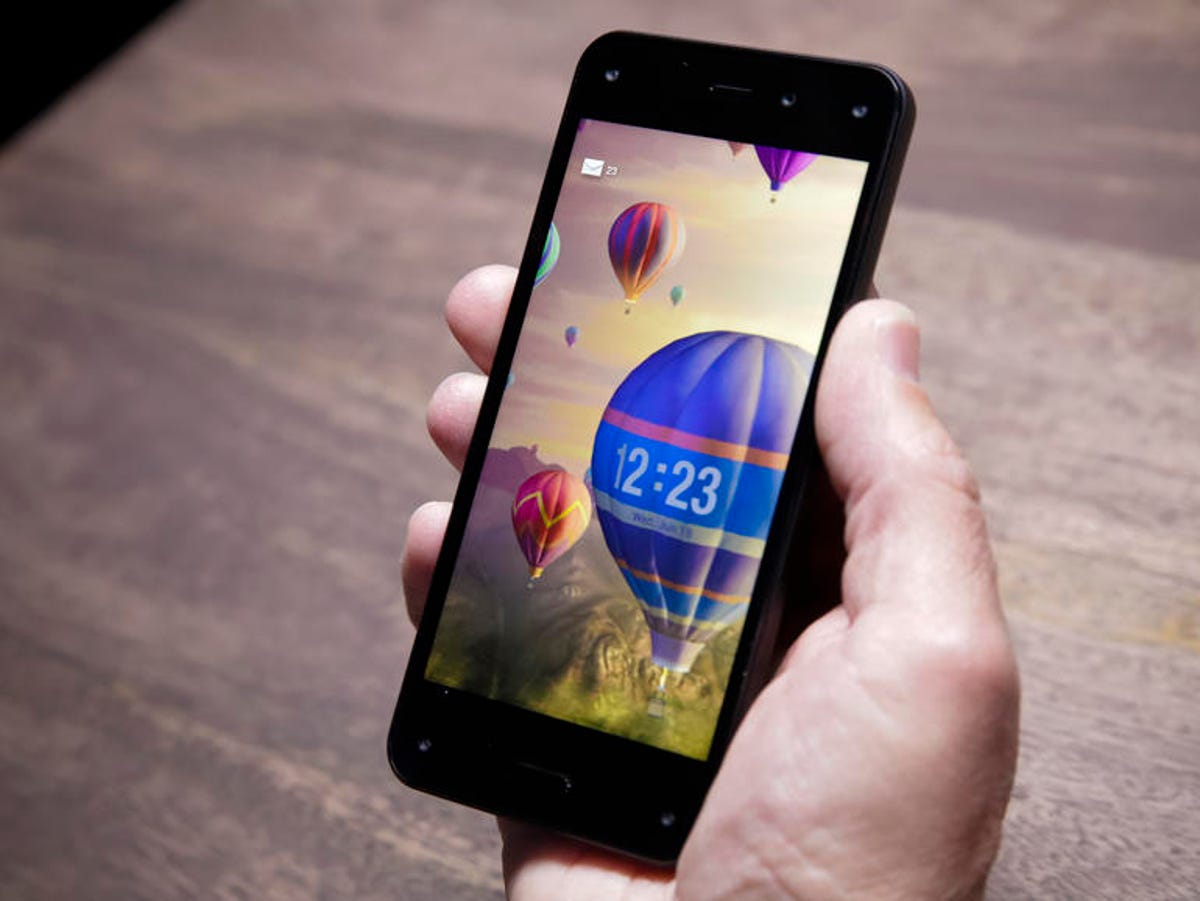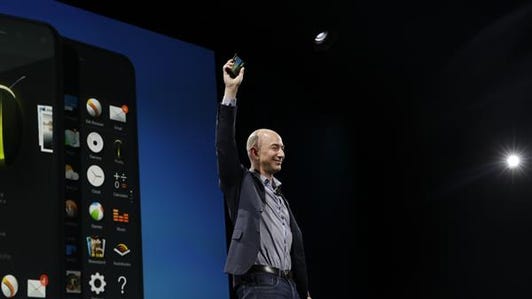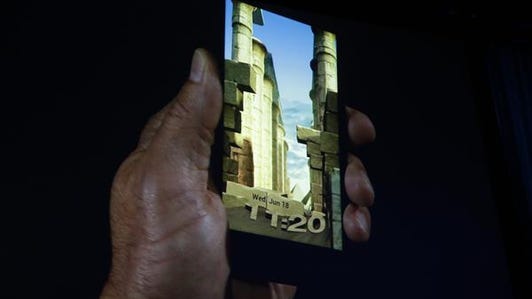
James Martin/CNET
Amazon’s Fire Phone, already dubbed “yet another shiny black rectangle,” won’t spell the death of Apple’s iPhone or Samsung’s Galaxy smartphones anytime soon.
Jeff Bezos, CEO of the e-commerce juggernaut, on Wednesday introduced Amazon’s first smartphone, which displays 3D images and maps, and features a way to scroll through Web pages and books simply by tilting the phone. The Fire Phone, which runs a modified version of Google’s Android mobile operating system, also includes Amazon’s MayDay customer service feature. Most important, it touts a new app called Firefly that automatically identifies millions of different items, from books to barcodes, and gives users a fast and easy way to buy products from Amazon.
The phone, available starting July 25, will run exclusively on AT&T’s wireless network (at least for now) and sell for $199 for a 32-gigabyte version. Amazon is also throwing in a free year of its $99 Prime shipping and content services.
See also
- CNET’s take on the Amazon Fire Phone
- Amazon delivers long-rumored smartphone
- Fire Phone pulls together Amazon’s app universe onto one device
While the Amazon Fire Phone has a lot of bells and whistles sure to pique customers’ interest, the question remains whether any of those features is enough to turn those lookers into buyers. Many features, such as autoscrolling, appear more gimmicky than useful, early reviewers note . Meanwhile, the phone has its limitations, such as being available at only one carrier. And then there’s the price, which is, in the world of smartphones, high.
Samsung and Apple, the world’s top smartphone makers, don’t need to worry that the Fire Phone will erode their market share. “It ups the ante, but it’s not revolutionary to the point people will drop their phones and go out and buy it,” said Tuong Nguyen, an analyst with market researcher Gartner.
We’ve contacted Apple and Samsung for comment and will update the report when we have more information.
High-end features at a high-end priceThere are many factors working against Amazon and in favor of Apple and Samsung. One is that AT&T, which also partnered with Amazon to offer wireless service for its Kindle tablets, is the exclusive wireless provider for the device — at least for now (Amazon and AT&T declined to say how long that exclusive will last).
It’s become commonplace — in fact, almost expected — that a major new smartphone will be available through all the top carriers at the same time. Verizon Wireless customers don’t have to wait any longer for the iPhone 5S or Galaxy S5 than AT&T or T-Mobile customers do.
Carriers, which have lost a lot of their deal-making power to Apple and Samsung, have been looking for alternatives to the popular iPhones and Galaxy devices. So far, no one has really been able to challenge Apple and Samsung, despite increased marketing from the carriers. Amazon, which is a common household name, stood a strong chance, but it’s now limited to only AT&T, which ranks second after Verizon in terms of subscriber size.


Now playing:
Watch this:
Amazon’s new “3D” Fire Phone turns heads
4:36
Then there’s the Fire Phone’s pricing. Many analysts expected the device to follow Amazon’s low-cost strategy with the Kindle Fire tablets (which sell for about $100 to $200 less, on average, than Apple’s iPad) and/or to entice users by subsidizing part of their wireless data plans. Apple and Samsung dominate the market for high-end smartphones, which typically are characterized as unsubsidized phones priced at $400 and above, and the two companies even reach into the midrange. But one area they’re weak is low-cost devices.
The low end also happens to be where most smartphone growth is coming from. ARM Holdings, which provides chip technology used to power most of the world’s mobile devices, estimated earlier this year that the premium-smartphone segment would grow only about 4 percent each year through 2018 versus 14 percent annual growth for midrange devices and 17 percent annual growth for low-end phones.
Had Amazon released a less-expensive device — maybe akin to the Nexus products Google sells starting for $349, without a carrier subsidy — Bezos might have have carved out a nice niche for the company. Instead, Amazon will be going up against the two dominant high-end device makers, who together controlled nearly half of the smartphone market in the first quarter, according to research firm IDC.
Apple and Samsung both offer their newest smartphones at 16GB capacities for $199, and analysts have noted they’re the only ones making any money from smartphones.
All-in-all, the Fire Phone is a device designed to appeal to Amazon’s current customers, particularly those who have Prime accounts, own Kindles or Kindle Fires, and buy content and products from Amazon. The problem is that even though Amazon fans may look at the gadget, many already own iPhones or Galaxy devices. Tempting them away from their current phones by promising them an easier way to buy stuff at Amazon may not be a compelling enough proposition.
Going hands-on with the Amazon Fire Phone (pictures)






“There were good strategic reasons for Amazon to launch a smartphone, but the Fire Phone isn’t the phone Amazon should have launched,” said Jan Dawson, a Jackdaw research analyst. “Instead of something truly disruptive, Amazon has given the world (or technically just the US at this point) yet another shiny black rectangle.”
It’s likely that Amazon’s Fire Phone will have the same impact on the market as the Kindle Fire tablets. The first devices were initially seen as “iPad killers” because they were priced below Apple’s offerings. But in the first quarter of this year, Amazon’s global tablet market share totaled only 1.9 percent. Apple, meanwhile, has captured 33 percent of the market, while Samsung has a 22 percent share.
Bezos on Wednesday told a crowd of 300 journalists, developers, and members of the public, all of whom had to apply for their seats at the event in Amazon’s hometown of Seattle, that Amazon wanted to make a better phone for its most engaged customers and that it wanted to create something “a little bit different.”
“Fire is the only smartphone to put everything you love about Amazon in the palm of your hand,” Bezos wrote in a note on Amazon’s home page.
Amazon’s tablets didn’t kill — or even maim — Samsung and Apple. The Fire Phone doesn’t seem to be any different, despite Bezos’ pitch.
A closer look at the Amazon Fire phone (pictures)









